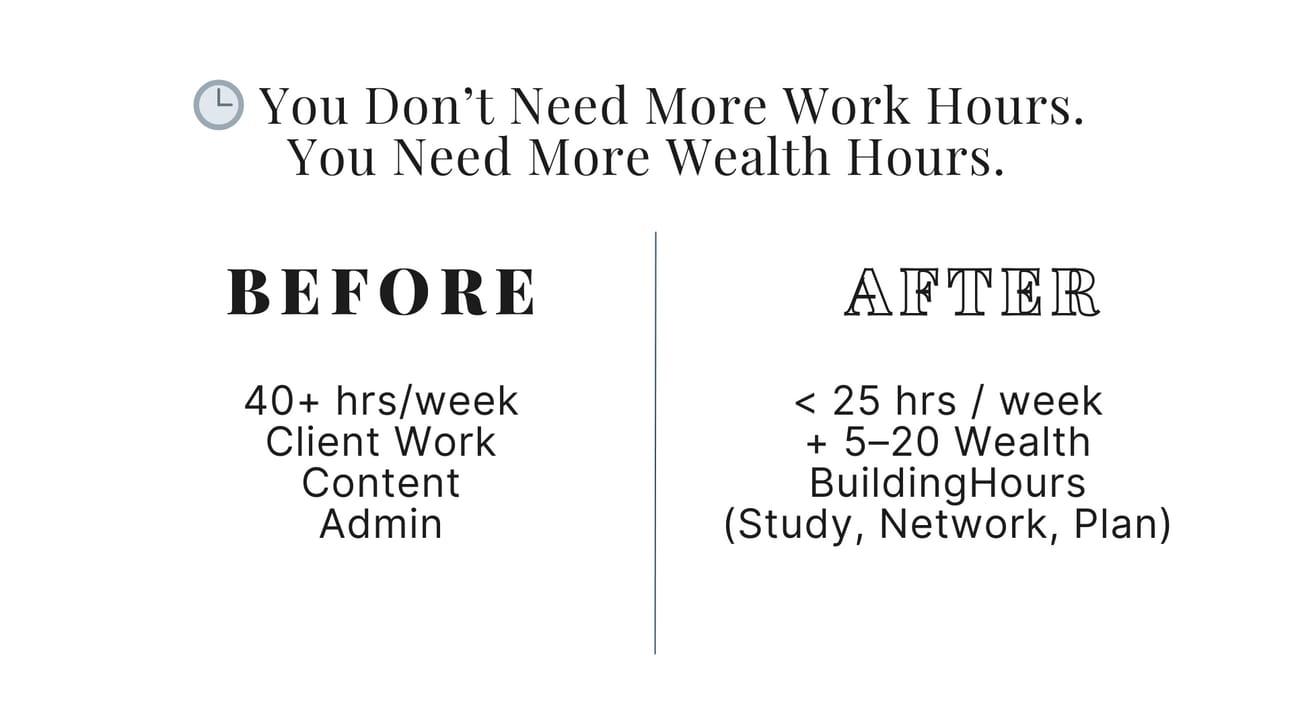- 1% Insider
- Posts
- 5 Shifts You Need to Make to Join the Top 1%
5 Shifts You Need to Make to Join the Top 1%
On the Path to the Top 1%? These Shifts Are Non-Negotiables
If you’re an entrepreneur, chances are you started your business to create more freedom, more income, and more impact.
But if you’re anything like me, at some point you realized… Income is not the same as generational wealth.
You can work your butt off, hit your revenue goals, and still not build something that lasts beyond your lifetime.
That’s the wake-up call I had not too long ago.
After being in the room of a number of generationally wealthy individuals - I witnessed first hand how they think and how they build wealth.
I’ve been lucky enough to be personally mentored by a number of them and this mentorship pushed me to make 5 key shifts — changes that radically transformed how I think about money, business, and what it really means to build generational wealth.
This isn’t theory. These are the exact moves I made (and continue to make) to shift from short-term income to long-term wealth creation — without burning out or giving up the business I love.
While I have so much more to share than these 5 - they are the ones that helped me the most at the beginning of my journey.
SHIFT 1: Your business is likely a vehicle for lifestyle money vs wealth

Having a business is amazing. It’s a gift. It creates freedom, income, and impact.
But…
Your business alone is probably not the thing that’s going to build your generational wealth.
It can be for some (think Sara Blakely and Spanx) but for most, your main business will not be your vehicle for wealth.
Rihanna didn’t become a billionaire from selling albums.
She became a billionaire by building Fenty — a strategic equity play, backed by luxury conglomerate LVMH.
Rihanna owns 50% of Fenty (LVMH the other 50%). And while the company brings in millions in annual revenue, the valuation of the company is over 2 Billion dollars - making Rhianna a billionaire.
Her vehicle for lifestyle money was not the same as her vehicle for wealth (though it definitely helped her create wealth opportunities).
That’s what I realized about my own business.
It provides amazing income, but it’s also a vehicle — one I can use to fund real wealth-building assets.
While my audience isn’t at the place where I can leverage it for generational wealth opportunities, I do carve out at least 10% of everything I make and put it toward vehicles for wealth.
Personally I invest in other companies.
One company I invested in, as an example, builds 3D-printed homes using recycled materials — with active contracts from government agencies to solve housing challenges. They’re scaling fast. Their valuation is expected to rise. And at a certain point, they’ll start paying out distributions to investors.
My goal isn’t just to make money. It’s to own assets that appreciate in value and generate cash without me.
🎯 Try this:
Create a second business bank account and name it your “Wealth Fund.”
Every time money hits your main account, automatically transfer 10% to your Wealth Fund. Start tracking what opportunities that fund could grow into.
SHIFT 2: Cap Your Active Work at 25 Hours/Week
Most people think the goal is to “scale” by doing more.
More launches. More content. More clients. More hours.
But if you’re always working in the business, when do you work on your wealth?
I made a hard line in my calendar:
No more than 25 hours per week of active business work.
In fact, I’m currently getting it down to 5 - 8 hours per week.
Not so I can nap all day or spend all of my days at the beach. But because the real wealth-building happens in the hours outside of client delivery and content creation.

I use that time to:
Learn how to create generational wealth (from people who’ve done it)
Be in rooms where people do deals or learn to build relationships with potential strategic partners.
Connect with people in high-net-worth rooms
Research how to buy or build companies with smart valuation potential
Explore deals where I can be an owner, not an operator
This is how you start thinking like the 1%.
Because they’re not booked wall-to-wall with meetings. They’re creating space for strategy, creativity, and execution at scale.
🎯 Try this:
Audit your calendar.
What can be delegated, paused, or eliminated to open up just 5–10 “Wealth Hours” a week? Use that time to study, network, or plan your next wealth-building move.
SHIFT 3: There’s No One Path — But There Are Principles
If you’ve ever been told, “You need to get into real estate” — pause.
That might work for some. But wealth isn’t a one-size-fits-all game.
The secret is not following one path. It’s developing your lens so you can see the right path for you.
Personally, I don’t love the idea of managing a bunch of rental properties. Even with property managers, it’s still not passive enough for me. I’m open to having a few, but I’m personally excited about other opportunities.
What excites me?
Investing in businesses with mission-driven founders
Buying businesses that need my skills (especially ones that just need a marketing makeover or better brand positioning)
Investing in Crypto
For example, I invested in a business led by a founder who had already sold multiple companies — one for nearly $2B. When someone like that invites you in, you don’t hesitate. It’s in an industry my sister knows really well and that I’m fairly familiar with.
What I’ve learned is that the 1% don’t focus on chasing trends. They typically invest in a lane or two and are willing to take strategic risk in new opportunities.
🎯 Try this:
Choose one sector you’re curious about (real estate, startups, boring businesses, content licensing, etc.).
Commit to learning about it for 30 minutes a week. Not to jump in fast — but to train your lens. Then increase the amount of time you can dedicate every week.
SHIFT 4: Mindset Must Be Part of Your Wealth Strategy
This isn’t just about spreadsheets and structures.
It’s also about energy, identity, and belief.
If you feel guilt when charging more…
If you avoid checking your numbers…
If you see money as scary or “not spiritual”…
…you will unconsciously block the very thing you’re trying to call in.
The most successful people I’ve met don’t hoard money.
They honor it. They have a clear vision for why they want it — and what they’ll do with it.
One of my mentors taught me:
“Your mind has to arrive before your money does.”
That’s why I have a money manifesto — a personal document I revisit every month.
It spells out my vision, my goals, and how I want to partner with money as a force for good.

🎯 Try this:
Take 15 minutes and have a partnership conversation with money. Speak about the impact you want to make in the world, your role and money’s role in making it happen.
SHIFT 5: Build a Business That’s Valuable — Not Just Profitable
Here’s one of the most powerful things I’ve learned:
It’s faster to build a business that’s worth $1.5M and borrow against it…
than it is to earn $1M in revenue.
Valuation is the real flex.
When your business has recurring revenue, assets, systems, and brand equity, it becomes something you can borrow against, sell, or use to open bigger doors.
I’ve started structuring my companies differently:
I use holding companies and LLCs to separate assets
I’m moving toward trust ownership to build protection and leverage
I’m not chasing high income — I’m increasing my company’s value on paper
This is how the wealthy can live off loans — because debt isn’t taxed and income is.
They don’t just become wealthy — they get liquid leverage.
🎯 Try this:
Ask yourself the following questions:
What would make my business more valuable to someone else? This could be apps, IP, software, etc.
Could it run without me?
Could it sell products while I sleep?
Could it hold intellectual property, systems, or contracts that increase valuation?
These questions are to get you thinking. Ask them regularly. Make it one of your main jobs to think about how to increase company assets and valuation.

🔁 Recap: The 5 Shifts That Changed My Life
Your income-generating biz is just the beginning. Use it to fund real assets.
Cap your hours to create capacity for wealth-building.
There’s no single path — but there are patterns. Learn to spot the right opportunities.
Transform how you think and feel about money.
Build something valuable, not just profitable.
The Bigger Picture
Here’s the truth: Generational wealth isn’t just about passing down money.
It’s about passing down wisdom.
It’s about passing down values, beliefs, and frameworks that empower the next generation to do even more good, build even more wealth, and live even more fully — without starting from scratch.
That’s why I created the 1% Insider newsletter.
It’s where I share the behind-the-scenes strategies, insights, and moves I’m making on my journey to building generational wealth — so you can apply them to your own life and legacy.
We’ll discuss income, investments, influence, and identity — all through the lens of building real, lasting, meaningful wealth.
If you're ready to stop playing small and start creating the kind of legacy that lives on long after you're gone…
👉 Join the 1% Insider newsletter.
Because wealth is more than money — it’s the impact you make with it.
